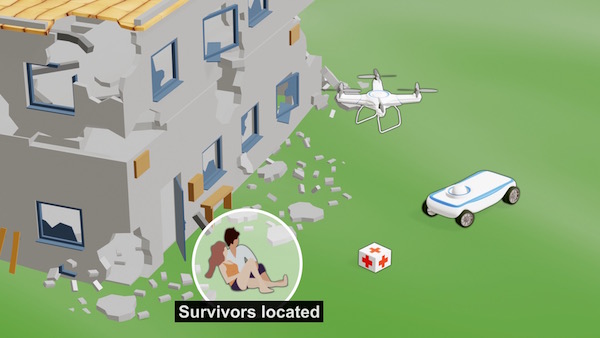Leveraging Artificial Intelligence in Search and Rescue Operations
WEST LAFAYETTE, Ind. - Rescue teams descended on the destruction left by Hurricane Michael in October, frantically searching for survivors. But a week later, more than 1,000 people were still not accounted for, leaving families to wait and hope.
Drone assistance in natural disaster response now is simplistic at best with a number of hurdles. But new research led by Purdue University professors is working to use artificial intelligence and learning algorithms to create a platform allowing multiple drones to communicate and adapt as mission factors change.
Shaoshuai Mou and Dan DeLaurentis, professors in aeronautics and astronautics, are leading the research, which received three-year funding from Northrop Grumman Corp. as part of the Real Applications of Learning Machine consortium.
 "For the system, we focused on a multi-agent network of vehicles, which are diverse and can coordinate with each other," Mou said. "Such local coordination will allow them to work as a cohesive whole to accomplish complicated missions such as search and rescue."
"For the system, we focused on a multi-agent network of vehicles, which are diverse and can coordinate with each other," Mou said. "Such local coordination will allow them to work as a cohesive whole to accomplish complicated missions such as search and rescue."
"There are challenges in this area. The environment may be dynamic, for example, with the weather changing. The drones have to be adaptive and must be capable of real-time environment perception and on-line autonomous decision making."
Distributed control, human-machine mixed autonomy, life-long learning and artificial intelligence will be key enablers to the proposed research, Mou said.
A YouTube animation can be seen below.
In this research, AI and machine learning techniques will assist the system in many ways, such as in object recognition and human-machine communication, and improving the system performance over time. Especially the system assisted by AI will allow for input from a human commander into the mission parameters and lets the drones provide feedback and even suggestions in natural language.
"For complex situations, we still need to involve humans in the loop and try to do mixed autonomy consisting of machines and humans," Mou said.
In the mission scenarios, a ground-based powerful-processing vehicle will communicate to either air, ground or aquatic drones that can cover a wide area.
"The utilization of the combination of heterogenous vehicles should be a key to so many complicated problems," Mou said.
Mou and DeLaurentis are joined on the project by faculty from the University of Illinois-Chicago and University of Massachusetts at Amherst.
The work aligns with Purdue's Giant Leaps celebration, acknowledging the university's global advancements made in artificial intelligence as part of Purdue's 150th anniversary. This is one of the four themes of the yearlong celebration's Ideas Festival, designed to showcase Purdue as an intellectual center solving real-world issues.
Writer: Brian Huchel, 765-494-2084, [email protected]
Source: Shaoshuai Mou, 765-494-2546, [email protected]
- Tags:
- artificial intelligence (AI)
- Brian Huchel
- Dan DeLaurentis
- disaster response
- distributed control
- drone assistance
- human-machine communication
- human-machine mixed autonomy
- Hurricane Michael
- learning algorithms
- machine learning
- natural disasters
- natural language processing
- Northrop Grumman
- object recognition
- Perdue University
- Real Applications of Learning Machine
- search and rescue operations
- Shaoshuai Mou
- University of Illinois-Chicago
- University of Massachusetts-Amherst
- Login to post comments